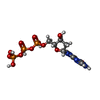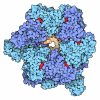+ Open data
Open data
- Basic information
Basic information
| Entry |  | |||||||||
|---|---|---|---|---|---|---|---|---|---|---|
| Title | apPol-DNA-nucleotide complex (ternary2) | |||||||||
 Map data Map data | DeepEMhancer sharpened map | |||||||||
 Sample Sample |
| |||||||||
 Keywords Keywords | DNA polymerase / REPLICATION | |||||||||
| Function / homology |  Function and homology information Function and homology information3'-5' exonuclease activity / DNA-templated DNA replication / single-stranded DNA binding / 5'-3' DNA helicase activity / DNA-directed DNA polymerase activity / ATP binding Similarity search - Function | |||||||||
| Biological species |  | |||||||||
| Method | single particle reconstruction / cryo EM / Resolution: 4.2 Å | |||||||||
 Authors Authors | Lahiri I / Kumari A | |||||||||
| Funding support |  India, India,  United Kingdom, 2 items United Kingdom, 2 items
| |||||||||
 Citation Citation |  Journal: Nucleic Acids Res / Year: 2025 Journal: Nucleic Acids Res / Year: 2025Title: Structural basis of multitasking by the apicoplast DNA polymerase from Plasmodium falciparum. Authors: Anamika Kumari / Theodora Enache / Timothy D Craggs / Janice D Pata / Indrajit Lahiri /   Abstract: Plasmodium falciparum is a eukaryotic pathogen responsible for the majority of malaria-related fatalities. Plasmodium belongs to the phylum Apicomplexa and, like most members of this phylum, contains ...Plasmodium falciparum is a eukaryotic pathogen responsible for the majority of malaria-related fatalities. Plasmodium belongs to the phylum Apicomplexa and, like most members of this phylum, contains a non-photosynthetic plastid called the apicoplast. The apicoplast has its own genome, replicated by a dedicated replisome. Unlike other cellular replisomes, the apicoplast replisome uses a single DNA polymerase (apPol). This suggests that apPol can multitask and catalyse both replicative and lesion bypass synthesis. Replicative synthesis relies on a restrictive active site for high accuracy while lesion bypass typically requires an open active site. This raises the question: how does apPol combine the structural features of multiple DNA polymerases in a single protein? Using single-particle electron cryomicroscopy (cryoEM), we have solved the structures of apPol bound to its undamaged DNA and nucleotide substrates in five pre-chemistry conformational states. We found that apPol can accommodate a nascent base pair with the fingers in an open configuration, which might facilitate the lesion bypass activity. In the fingers-open state, we identified a nascent base pair checkpoint that preferentially selects Watson-Crick base pairs, an essential requirement for replicative synthesis. Taken together, these structural features might explain how apPol balances replicative and lesion bypass synthesis. | |||||||||
| History |
|
- Structure visualization
Structure visualization
| Supplemental images |
|---|
- Downloads & links
Downloads & links
-EMDB archive
| Map data |  emd_53374.map.gz emd_53374.map.gz | 40.6 MB |  EMDB map data format EMDB map data format | |
|---|---|---|---|---|
| Header (meta data) |  emd-53374-v30.xml emd-53374-v30.xml emd-53374.xml emd-53374.xml | 22.3 KB 22.3 KB | Display Display |  EMDB header EMDB header |
| FSC (resolution estimation) |  emd_53374_fsc.xml emd_53374_fsc.xml | 7.6 KB | Display |  FSC data file FSC data file |
| Images |  emd_53374.png emd_53374.png | 56.8 KB | ||
| Masks |  emd_53374_msk_1.map emd_53374_msk_1.map | 45.2 MB |  Mask map Mask map | |
| Filedesc metadata |  emd-53374.cif.gz emd-53374.cif.gz | 6.7 KB | ||
| Others |  emd_53374_additional_1.map.gz emd_53374_additional_1.map.gz emd_53374_half_map_1.map.gz emd_53374_half_map_1.map.gz emd_53374_half_map_2.map.gz emd_53374_half_map_2.map.gz | 42.7 MB 42 MB 42 MB | ||
| Archive directory |  http://ftp.pdbj.org/pub/emdb/structures/EMD-53374 http://ftp.pdbj.org/pub/emdb/structures/EMD-53374 ftp://ftp.pdbj.org/pub/emdb/structures/EMD-53374 ftp://ftp.pdbj.org/pub/emdb/structures/EMD-53374 | HTTPS FTP |
-Validation report
| Summary document |  emd_53374_validation.pdf.gz emd_53374_validation.pdf.gz | 931.1 KB | Display |  EMDB validaton report EMDB validaton report |
|---|---|---|---|---|
| Full document |  emd_53374_full_validation.pdf.gz emd_53374_full_validation.pdf.gz | 930.6 KB | Display | |
| Data in XML |  emd_53374_validation.xml.gz emd_53374_validation.xml.gz | 14.7 KB | Display | |
| Data in CIF |  emd_53374_validation.cif.gz emd_53374_validation.cif.gz | 19.4 KB | Display | |
| Arichive directory |  https://ftp.pdbj.org/pub/emdb/validation_reports/EMD-53374 https://ftp.pdbj.org/pub/emdb/validation_reports/EMD-53374 ftp://ftp.pdbj.org/pub/emdb/validation_reports/EMD-53374 ftp://ftp.pdbj.org/pub/emdb/validation_reports/EMD-53374 | HTTPS FTP |
-Related structure data
| Related structure data |  9qu8MC  9qscC  9quaC  9qujC  9qunC  9qv9C C: citing same article ( M: atomic model generated by this map |
|---|---|
| Similar structure data | Similarity search - Function & homology  F&H Search F&H Search |
- Links
Links
| EMDB pages |  EMDB (EBI/PDBe) / EMDB (EBI/PDBe) /  EMDataResource EMDataResource |
|---|---|
| Related items in Molecule of the Month |
- Map
Map
| File |  Download / File: emd_53374.map.gz / Format: CCP4 / Size: 45.2 MB / Type: IMAGE STORED AS FLOATING POINT NUMBER (4 BYTES) Download / File: emd_53374.map.gz / Format: CCP4 / Size: 45.2 MB / Type: IMAGE STORED AS FLOATING POINT NUMBER (4 BYTES) | ||||||||||||||||||||||||||||||||||||
|---|---|---|---|---|---|---|---|---|---|---|---|---|---|---|---|---|---|---|---|---|---|---|---|---|---|---|---|---|---|---|---|---|---|---|---|---|---|
| Annotation | DeepEMhancer sharpened map | ||||||||||||||||||||||||||||||||||||
| Projections & slices | Image control
Images are generated by Spider. | ||||||||||||||||||||||||||||||||||||
| Voxel size | X=Y=Z: 1.06 Å | ||||||||||||||||||||||||||||||||||||
| Density |
| ||||||||||||||||||||||||||||||||||||
| Symmetry | Space group: 1 | ||||||||||||||||||||||||||||||||||||
| Details | EMDB XML:
|
-Supplemental data
-Mask #1
| File |  emd_53374_msk_1.map emd_53374_msk_1.map | ||||||||||||
|---|---|---|---|---|---|---|---|---|---|---|---|---|---|
| Projections & Slices |
| ||||||||||||
| Density Histograms |
-Additional map: B factor sharpened map
| File | emd_53374_additional_1.map | ||||||||||||
|---|---|---|---|---|---|---|---|---|---|---|---|---|---|
| Annotation | B factor sharpened map | ||||||||||||
| Projections & Slices |
| ||||||||||||
| Density Histograms |
-Half map: #2
| File | emd_53374_half_map_1.map | ||||||||||||
|---|---|---|---|---|---|---|---|---|---|---|---|---|---|
| Projections & Slices |
| ||||||||||||
| Density Histograms |
-Half map: #1
| File | emd_53374_half_map_2.map | ||||||||||||
|---|---|---|---|---|---|---|---|---|---|---|---|---|---|
| Projections & Slices |
| ||||||||||||
| Density Histograms |
- Sample components
Sample components
-Entire : Ternary complex of apicoplast DNA polymerase with DNA and dGTP
| Entire | Name: Ternary complex of apicoplast DNA polymerase with DNA and dGTP |
|---|---|
| Components |
|
-Supramolecule #1: Ternary complex of apicoplast DNA polymerase with DNA and dGTP
| Supramolecule | Name: Ternary complex of apicoplast DNA polymerase with DNA and dGTP type: complex / ID: 1 / Parent: 0 / Macromolecule list: #1-#3 |
|---|---|
| Source (natural) | Organism:  |
| Molecular weight | Theoretical: 95 KDa |
-Macromolecule #1: Plastid replication-repair enzyme
| Macromolecule | Name: Plastid replication-repair enzyme / type: protein_or_peptide / ID: 1 / Number of copies: 1 / Enantiomer: LEVO |
|---|---|
| Source (natural) | Organism:  |
| Molecular weight | Theoretical: 76.473484 KDa |
| Recombinant expression | Organism:  |
| Sequence | String: MGSSHHHHHH SQDPENLYFQ GDEITKKYIK DNIINVDDNI IKKKDIFKLK NENNEITECA FEYFESKKKF DDDIESRFFI INDNNYNEN INLIYKDIKY CGLNIQTTGL EVFDENIRLI QIAVENYPVI IYDMFNINKK DILDGLRKVL ENKNIIKIIQ N GKFDAKFL ...String: MGSSHHHHHH SQDPENLYFQ GDEITKKYIK DNIINVDDNI IKKKDIFKLK NENNEITECA FEYFESKKKF DDDIESRFFI INDNNYNEN INLIYKDIKY CGLNIQTTGL EVFDENIRLI QIAVENYPVI IYDMFNINKK DILDGLRKVL ENKNIIKIIQ N GKFDAKFL LHNNFKIENI FDTYIASKLL DKNKNMYGFK LNNIVEKYLN VILDKQQQNS VWNNSLLNNN QLFYAARDSS CL LKLYKKL KEEIKKENLH IVNDIENKCI LPICDMELNG IKVDLENLQK STNEILNELN IEKDNLKKKL KDENINVNSQ QQV LKALQK NNVRDISNKL IENTSDSNLK NFLNHEEIIS LRNYRRLYKL YSAFYLKLPL HINTKTNKIH TTFNQLKTFS GRFS SEKPN LQQIPRQKNI REIFIPNDNN IFIIADFKQI ELKIAAEITN DEIMLKAYNN NIDLHTLTAS IITKKNIPDI NKEDR HIAK AINFGLIYGM NYVNLKNYAN TYYGLNMSLD QCLYFYNSFF EHYKGIYKWH NQVKQKRALQ YSTLSNRKVI FPYFSF TKA LNYPVQGTCA DILKLALVDL YDNLKDINGK IILCVHDEII IEVNKKFQEE ALKILVQSME NSASYFLKKV KCEVSVK IA ENWGSKD UniProtKB: Plastid replication-repair enzyme |
-Macromolecule #2: DNA primer strand
| Macromolecule | Name: DNA primer strand / type: dna / ID: 2 / Number of copies: 1 / Classification: DNA |
|---|---|
| Source (natural) | Organism: DNA molecule (others) |
| Molecular weight | Theoretical: 7.714971 KDa |
| Sequence | String: (DC)(DA)(DG)(DG)(DT)(DG)(DT)(DC)(DA)(DG) (DT)(DC)(DA)(DG)(DC)(DT)(DA)(DG)(DT)(DG) (DC)(DT)(DG)(DA)(DC) |
-Macromolecule #3: DNA template strand
| Macromolecule | Name: DNA template strand / type: dna / ID: 3 / Number of copies: 1 / Classification: DNA |
|---|---|
| Source (natural) | Organism: DNA molecule (others) |
| Molecular weight | Theoretical: 11.02308 KDa |
| Sequence | String: (DG)(DC)(DT)(DA)(DC)(DC)(DG)(DT)(DA)(DG) (DC)(DG)(DT)(DC)(DA)(DG)(DC)(DA)(DC)(DT) (DA)(DG)(DC)(DT)(DG)(DA)(DC)(DT)(DG) (DA)(DC)(DA)(DC)(DC)(DT)(DG) |
-Macromolecule #4: 2'-DEOXYGUANOSINE-5'-TRIPHOSPHATE
| Macromolecule | Name: 2'-DEOXYGUANOSINE-5'-TRIPHOSPHATE / type: ligand / ID: 4 / Number of copies: 1 / Formula: DGT |
|---|---|
| Molecular weight | Theoretical: 507.181 Da |
| Chemical component information |  ChemComp-DGT: |
-Experimental details
-Structure determination
| Method | cryo EM |
|---|---|
 Processing Processing | single particle reconstruction |
| Aggregation state | particle |
- Sample preparation
Sample preparation
| Buffer | pH: 7.5 |
|---|---|
| Vitrification | Cryogen name: ETHANE |
- Electron microscopy
Electron microscopy
| Microscope | TFS KRIOS |
|---|---|
| Temperature | Min: 77.0 K / Max: 77.0 K |
| Specialist optics | Energy filter - Slit width: 20 eV |
| Image recording | Film or detector model: GATAN K3 BIOCONTINUUM (6k x 4k) / Number grids imaged: 1 / Number real images: 16189 / Average exposure time: 1.0 sec. / Average electron dose: 70.0 e/Å2 |
| Electron beam | Acceleration voltage: 300 kV / Electron source:  FIELD EMISSION GUN FIELD EMISSION GUN |
| Electron optics | C2 aperture diameter: 50.0 µm / Calibrated defocus max: 3.8000000000000003 µm / Calibrated defocus min: 0.8 µm / Calibrated magnification: 81000 / Illumination mode: FLOOD BEAM / Imaging mode: BRIGHT FIELD / Cs: 2.7 mm / Nominal defocus max: 3.8000000000000003 µm / Nominal defocus min: 0.8 µm / Nominal magnification: 81000 |
| Sample stage | Specimen holder model: FEI TITAN KRIOS AUTOGRID HOLDER / Cooling holder cryogen: NITROGEN |
| Experimental equipment |  Model: Titan Krios / Image courtesy: FEI Company |
 Movie
Movie Controller
Controller













 Z (Sec.)
Z (Sec.) Y (Row.)
Y (Row.) X (Col.)
X (Col.)






















































